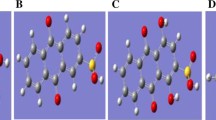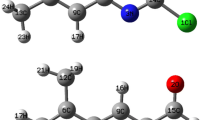Abstract
A number of compounds related to quinone derivatives is investigated by means of density functional theory in the B3LYP/6-31G(d) mode. Vertical electron affinity E va and/or electron affinity E a for the investigated compounds are known from experiments. The correlation between the calculated energies of π* molecular orbitals with the E va values measured via electron transmission spectroscopy is determined with a coefficient of 0.96. It is established that theoretical values of the adiabatic electron affinity, calculated as the difference between the total energies of a neutral molecule and a radical anion, correlate with E a values determined from electron transfer experiments with a correlation coefficient of 0.996.
Similar content being viewed by others
References
N. El. Najjar, H. Gali-Muhtasib, R. A. Ketola, et al., Phytochem. Rev., No. 10, 353 (2011).
D. V. Berdyshev, V. P. Glazunov, and V. L. Novikov, Russ. Chem. Bull. 56, 413 (2007).
E. Vessally, E. Fereyduni, M. Kamaee, and S. Moradi, J. Serb. Chem. Soc., No. 76, 879 (2011).
A. G. M. Tielens, C. Rotte, J. J. van Hellemond, and W. Martin, Trends Biochem. Sci., No. 27, 564 (2002).
F. A. de Lima Ribeiro and M. M. C. Ferreira, J. Mol. Struct: THEOCHEM, No. 719, 191 (2005).
E. Illenberger and J. Momigny, Gaseous Molecular Ions. An Introduction to Elementary Processes Induced by Ionization (Steinkopff Verlag Darmstadt, Springer, New York, 1992).
V. I. Khvostenko, Mass-Spectrometry of Negative Ions in Organic Chemistry (Nauka, Moscow, 1980) [in Russian].
R. R. Corderman and W. C. Lineberger, Ann. Rev. Phys. Chem., No. 30, 347 (1979).
P. Kebarle and S. Chowdhury, Chem. Rev., No. 7, 513 (1987).
G. J. Schulz, Rev. Mod. Phys., No. 45, 378 (1973).
K. D. Jordan and P. D. Burrow, Chem. Rev. 87, 557 (1987).
S. S. Staley and J. T. Strnad, J. Phys. Chem. 98, 116 (1994).
P. D. Burrow and A. Modelli, SAR QSAR Environ. Res. 24, 647 (2013).
A. M. Scheer and P. D. Burrow, J. Phys. Chem. B 110, 17751 (2006).
A. Modelli, Phys. Chem. Chem. Phys., No. 5, 2923 (2003).
A. Modelli and L. Mussoni, Chem. Phys. 332, 367 (2007).
T. Koopmans, Phys. Amsterdam, No. 1, 104 (1934).
J. M. Younkin, L. J. Smith, and R. N. Compton, Theor. Chim. Acta, No. 41, 157 (1976).
D. A. Chen and G. A. Gallup, J. Chem. Phys. 93, 8893 (1990).
K. Aflatooni, B. Hitt, G. A. Gallup, and P. D. Burrow, J. Chem. Phys. 115, 6489 (2001).
K. Aflatooni, G. A. Gallup, and P. D. Burrow, J. Phys. Chem. A 106, 4703 (2002).
A. Modelli and L. Szepes, Chem. Phys. 286, 165 (2003).
A. Modelli, L. Mussoni, and D. Fabbri, J. Phys. Chem. A 110, 6482 (2006).
J. C. Rienstra-Kiracofe, G. S. Tschumper, H. F. Schaefer III, et al., Chem. Rev. 102, 231 (2002).
X.-Q. Zhu and Ch.-H. Wang, J. Org. Chem. 75, 5037 (2010).
A. Modelli, B. Hajgato, J. F. Nixon, and L. Nyulaszi, J. Phys. Chem. A 108, 7440 (2004).
A. Modelli, L. Mussoni, and D. Fabbri, J. Phys. Chem. A 110, 6482 (2006).
S. Chowdhury, T. Heinis, E. P. Grimsrud, and P. Kebarle, J. Phys. Chem. 90, 2747 (1986).
T. Heinis, S. Chowdhury, and S. L. Scott, J. Am. Chem. Soc. 110, 400 (1988).
Author information
Authors and Affiliations
Corresponding author
Additional information
Original Russian Text © L.R. Kalimullina, E.P. Nafikova, N.L. Asfandiarov, Yu.V. Chizhov, G.Sh. Baibulova, E.R. Zhdanov, R.M. Gadiev, 2015, published in Zhurnal Fizicheskoi Khimii, 2015, Vol. 89, No. 3, pp. 426–432.
Rights and permissions
About this article
Cite this article
Kalimullina, L.R., Nafikova, E.P., Asfandiarov, N.L. et al. Theoretical estimation of the electron affinity for quinone derivatives by means of density functional theory. Russ. J. Phys. Chem. 89, 429–435 (2015). https://doi.org/10.1134/S0036024415030152
Received:
Published:
Issue Date:
DOI: https://doi.org/10.1134/S0036024415030152




